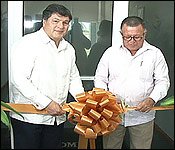
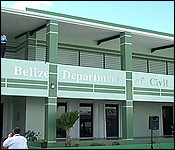
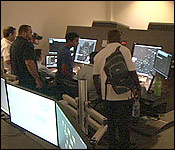
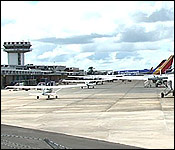 Yesterday, all over the world, those who work in the civil aviation industry celebrated International Civil Aviation Day.
Yesterday, all over the world, those who work in the civil aviation industry celebrated International Civil Aviation Day.
In Belize, the Civil Aviation Department postponed their observance until today when they inaugurated the newly built and equipped second floor of their headquarters at the Philip Goldson International Airport. 7News was there, and Daniel Ortiz got to see a few of the new toys that the Air Traffic Controllers got just in time for Christmas. Here's his story:
Daniel Ortiz reporting
The Minister of Civil Aviation and the President of COCESNA were the VIP's who cut the ribbon and officially opened the 2nd Floor of the Civil Aviation Department's Headquarters. It was the highlight of today's celebration of International Civil Aviation Day.
And why not? This building houses the state of the art equipment for the Air Traffic Controllers, newly purchased and installed.
In fact, just to access the building, one has to scan his or her thumbprint.
But, the shiniest of all the bells and whistles is this piece of equipment, a multi-million dollar radar system that the air traffic controllers are now making use of.
In here, they manage Belize's skies to ensure that all the local and international flights move around in our airspace without any mishaps.
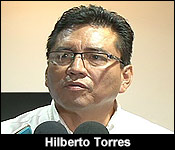 Hilberto Torres - Deputy Director, Civil Aviation
Hilberto Torres - Deputy Director, Civil Aviation
"Today we inaugurate the second floor of the department of civil aviation additional complex. What we housed here is the state of the art modern radar control center."
Lindsay Garbutt - Director, Civil Aviation
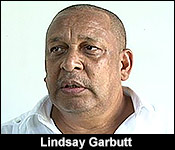 "Its around 13 million Belize dollars. About 11 million of that being the equipment and the rest being in infrastructure."
"Its around 13 million Belize dollars. About 11 million of that being the equipment and the rest being in infrastructure."
So, how does it work?
Daniel Ortiz, reporter
"Let's say for example a flight is coming in somewhere from the US per say. They enter Belizean air space. How does the air traffic controller assist in getting that airplane to safely land at the PGIA?"
Marsha Hinkson - Chief Air Traffic Control Officer
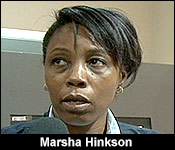 "What the controllers do, first to get in contact with that aircraft. Prior to it entering Belizean air space we would have the coordination. We have direct communication with Merida and that is our adjacent unit going towards United States. Therefore Merida would call us and give us that information. Even prior to that before the aircraft departs they would file what we called a flight plan. That is sent well ahead of time. Even when the aircraft departs we would get that information, so we can plan even 2 hours before the aircraft departs. Thereafter once the controller gets the information they would input some information in our system so that it would correlate what is given to us. So then when that aircraft is presented on the radar screen, when it comes within the range, it would then have the details of that flight with it. When it is transferred from Merida to Belize the controller would then accept control of it and he would then be given decent and if necessary speed restrictions to the aircraft."
"What the controllers do, first to get in contact with that aircraft. Prior to it entering Belizean air space we would have the coordination. We have direct communication with Merida and that is our adjacent unit going towards United States. Therefore Merida would call us and give us that information. Even prior to that before the aircraft departs they would file what we called a flight plan. That is sent well ahead of time. Even when the aircraft departs we would get that information, so we can plan even 2 hours before the aircraft departs. Thereafter once the controller gets the information they would input some information in our system so that it would correlate what is given to us. So then when that aircraft is presented on the radar screen, when it comes within the range, it would then have the details of that flight with it. When it is transferred from Merida to Belize the controller would then accept control of it and he would then be given decent and if necessary speed restrictions to the aircraft."
"Later in when it gets closer he would be doing what we called vectoring. Given the aircraft specific degrees to turn in order to bring him in line with the runway so that he could execute a safe landing."
Daniel Ortiz, reporter
"Is there any room for error any at all?"
Marsha Hinkson
"No room for error. We do a lot of training. It takes years to become an air traffic controller and the set of skills required as well. We have several people on duty and you tend to have to look out for each other. So if I make a mistake when I am controlling, then my colleague would catch up on that mistake. I could also do an immediate playback to say what I had said to this pilot or what this pilot has said to me and to catch up and then go back and make a correction. You cannot be afraid to make a correction. If you make a mistake, that's not a problem, but go back and make a correction."
And, the Director of Civil Aviation says that this piece of technology updates Belize's air traffic control to the same standards of the most developed countries in the world.
Lindsay Garbutt - Director, Civil Aviation
"Like aviation like most other technologies keep advancing. What this equipment has done for us - the equipment you find here you would find in any first world country. So it puts us on a level with them. We have been spending over the last 3 years around $400,000 a year just in capacity building for our staff and particularly for air traffic controllers."
"Now that we have well-trained staff and first class equipment, obviously that means a safer air space and better air space management."
Daniel Ortiz, reporter
"I've heard you say that Belize's air space is very busy."
Lindsay Garbutt - Director, Civil Aviation
"We have the busiest air space in Central America. Not the busiest as far as international flights is concern, but we have well over 100,000 local flights a year and I mean anyone who sits at the municipal or San Pedro or international airport see those planes leaving almost every 5 minutes and we are responsible for managing that. So these new equipment helps us to do that in a much secure and safe way."
There's only one caveat. It cannot assist Belize's authorities to track illegal planes, such as those carrying drug cargo, that enter Belize's airspace. This system depends on the honesty of the aircraft operators, to activate a piece of equipment that can communicate directly with this radar system.
Marsha Hinkson
"The aircraft need to be equip with what we called a transponder. It is a secondary surveillance radar, therefore it has to have that equipment on board. Apart from that they have to turn on the equipment. If they do not turn on the equipment, then they would not be able to be detected by the radar. We would be able to pick up aircraft which are first equip and secondly, the equipment is turn on."
The equipment upgrade was paid for by COCESSNA
Lindsay Garbutt - Director, Civil Aviation
"COCESNA is company that is owned by 6 countries, as if though it has 6 shareholders. Many year ago, I think it was in 1958, 5 Central American countries decided to put the air space together and manage it as one. In 1996 Belize joined them making it 6 countries. So all 6 countries of Central America with the exception of Panama, has a common air space and it is managed by the company called COCESNA. we always say there is not COCESNA and Belize, Belize is COCESNA, COCESNA is Belize and because we manage it that way, it means that the resources that COCESNA gets from the management of our space is shared in a very equitable manner between all countries. That is why they could have made this significant investment."
An investment like this one, will be present in all 6 member countries of COCESNA.
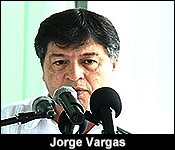 Jorge Vargas - President, COCESNA
Jorge Vargas - President, COCESNA
"COCESNA has initiate an integral investment plan that cover all the areas of air navigation such as communication, surveillance, atomization, meteorology for all the COCESNA member states. Just a few months ago I has the opportunity to be in an event similar like this opening the new air traffic control in Costa Rica. Today I have the opportunity to be in this moment in the inauguration of the air traffic control center for Belize and pretty soon in Tegucigalpa in San Pedro Sula."
The theme for international Civil Aviation day is, "Working together to ensure No Country is Left Behind".



